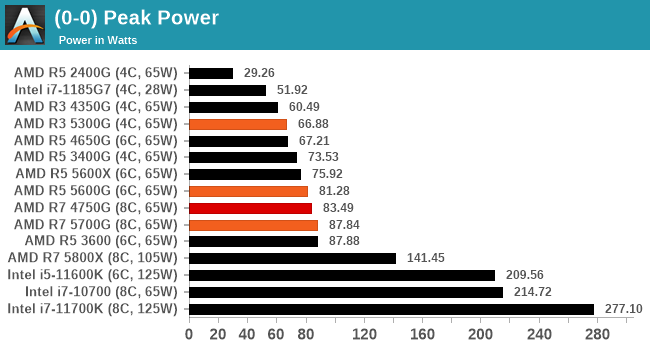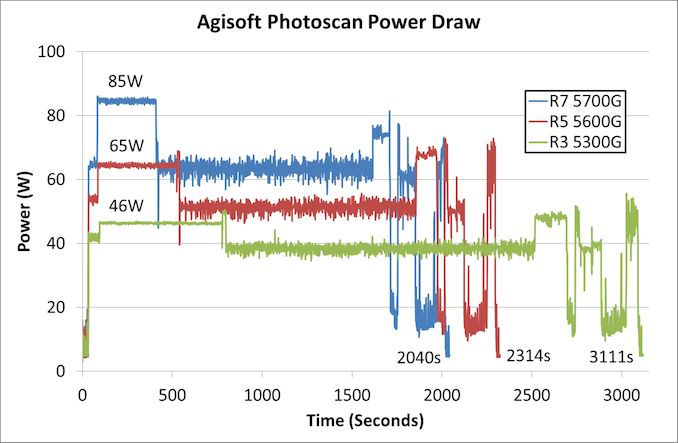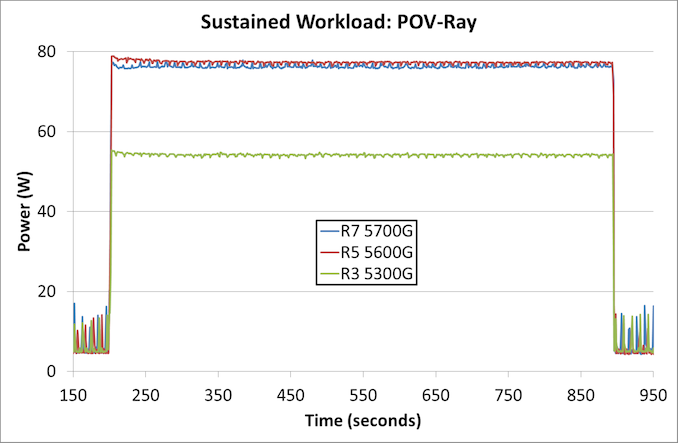The AMD Ryzen 7 5700G, Ryzen 5 5600G, and Ryzen 3 5300G Review
by Dr. Ian Cutress on August 4, 2021 1:45 PM ESTPower Consumption
The nature of reporting processor power consumption has become, in part, a dystopian nightmare. Historically the peak power consumption of a processor, as purchased, is given by its Thermal Design Power (TDP, or PL1). For many markets, such as embedded processors, that value of TDP still signifies the peak power consumption. For the processors we test at AnandTech, either desktop, notebook, or enterprise, this is not always the case.
Modern high-performance processors implement a feature called Turbo. This allows, usually for a limited time, a processor to go beyond its rated frequency. Exactly how far the processor goes depends on a few factors, such as the Turbo Power Limit (PL2), whether the peak frequency is hardcoded, the thermals, and the power delivery. Turbo can sometimes be very aggressive, allowing power values 2.5x above the rated TDP.
AMD and Intel have different definitions for TDP, but are broadly speaking applied the same. The difference comes to turbo modes, turbo limits, turbo budgets, and how the processors manage that power balance. These topics are 10000-12000 word articles in their own right, and we’ve got a few articles worth reading on the topic.
- Why Intel Processors Draw More Power Than Expected: TDP and Turbo Explained
- Talking TDP, Turbo and Overclocking: An Interview with Intel Fellow Guy Therien
- Reaching for Turbo: Aligning Perception with AMD’s Frequency Metrics
- Intel’s TDP Shenanigans Hurts Everyone
In simple terms, processor manufacturers only ever guarantee two values that are tied together - when all cores are running at base frequency, the processor should be running at or below the TDP rating. All turbo modes and power modes above that are not covered by warranty. Intel kind of screwed this up with the Tiger Lake launch in September 2020, by refusing to define a TDP rating for its new processors, instead of going for a range. Obfuscation like this is a frustrating endeavor for press and end-users alike.
However, for our tests in this review, we measure the power consumption of the processor in a variety of different scenarios. These include workflows, real-world image-model construction, and others as appropriate. These tests are done as comparative models. We also note the peak power recorded in any of our tests.
First up is our image-model construction workload, using our Agisoft Photoscan benchmark. This test has a number of different areas that involve single thread, multi-thread, or memory limited algorithms.
For the Ryzen 7 5700G, the most power-hungry part of the test is right at the beginning, where we’re seeing peaks of 85 W. For the 5600G, that first section goes to 65 W, but the peaks actually occur here near the end of the test. The 5300G also has peaks later in the test, but that first section is the lowest, running only at 46 W.
The second test is a sustained rendering workload.
In this instance, the Ryzen 3 5300G is nearer 55 W with a sustained workload over 10 minutes, while the Ryzen 5 and Ryzen 7 sit just below 80 W.
For peak power, we report the highest value observed from any of our benchmark tests.

While all three processors have a TDP rating of 65 W, by default on AMD systems the Package Power Tracking, which is the limiting factor here, is 88 W. The Ryzen 7 is practically at that value, while the Ryzen 5 just goes a smidge over 80 W. The Ryzen 3 on the other hand only matches its TDP in the worst-case scenario.












135 Comments
View All Comments
DanNeely - Wednesday, August 4, 2021 - link
"What makes these ones different this time around is that Intel is cutting the Ryzen 3 from retail,"AND here, not Intel.
dwillmore - Wednesday, August 4, 2021 - link
And they use Zen3 *processors*, not graphics.Rudde - Wednesday, August 4, 2021 - link
“As it stands, these two new processors at retail fill out Intel’s retail offerings, at least down to $259.”Again, it is AMD's retail offerings.
at_clucks - Wednesday, August 4, 2021 - link
Intel features prominently at the forefront of Ian's conscious mind. :)abufrejoval - Wednesday, August 4, 2021 - link
I thought that was pretty funny, but after so many years of reviewing CPUs perhaps it does become a bit tiresome.This chips would have made a huge wave two years ago and still received raving reviews a year ago.
Today it's still excellent, but no longer that exciting.
Good value, through.
nandnandnand - Wednesday, August 4, 2021 - link
Vega is showing its age. We all know the next big APU is Rembrandt with RDNA 2 graphics. After that, maybe Strix Point (rumored big/little).vlad42 - Thursday, August 5, 2021 - link
Rembrandt will most likely use RDNA1 as AMD just recently submitted drivers to the Linux kernel for a new RDNA1 based APU. It is unlikely they are planning to release another APU given we have not heard any rumors to that effect. Though I would love to be wrong!nandnandnand - Thursday, August 5, 2021 - link
No, it will use RDNA 2, just like Van Gogh (Steam Deck). That RDNA 1 APU is probably some embedded part.vlad42 - Thursday, August 5, 2021 - link
I have seen no indication of such a part from the roadmaps AMD has presented in the shareholder meetings. Every official roadmap has shown Van Gogh, Rembrandt and if I remember correctly, some other iteration of Renoir/Lucienne. Given that every previous embedded chip has just been a variation of the laptop/desktop SKUs, it is highly unlikely they would hide the existence of a new dedicated embedded chip from investors (they can get sued over that!).I guess it could be a semicustom part where the customer wants open source Linux drivers?
Remember how all the late stage rumors claimed Renoir and then Cezanne would use RDNA1, while the early rumors for both claimed Vega? New rumors that pop up in the months leading up to a new chip launch claiming radical technology changes from previous rumors, such as a change in GPU architecture, are normally wrong/bogus.
It seems more realistic to temper expectations and assume Rembrandt will use RDNA1 given the driver submission, fact that all early rumors suggested so, and that it is the only other APU we know of that is releasing in the near future.
vlad42 - Thursday, August 5, 2021 - link
Just saw your post down below. I must have missed that Yellow Carp was for an APU as well. For some reason, I thought it was for the entry level discrete market.Maybe I missed that there is a new embedded market chip (it's not like they get much news coverage) or it is a semicustom part like I suggested above. It seems too early for Yellow Carp to be for the Zen4 based APUs unless they are coming sooner than we think or AMD is starting to upstream driver work earlier.